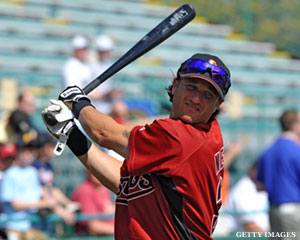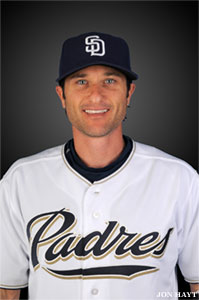It was a simple act. David Newhan held open a restaurant door for a person in a wheelchair. And yet he was overcome by emotion. Gratitude gave way to longing, longing gave way to resolve, resolve circled back to gratitude, and then he wanted nothing more than to find the nearest ballfield, crush a fastball and dash around the bases.
As the wheelchair rolled past, Newhan silently thanked God for his own miraculous luck. A surfing accident off the Southern California coast in September 2009 snapped the C2 vertebrae in his neck -- much the way it is done in a judicial hanging -- but Newhan’ spinal cord was somehow spared. He walked home unaware of the extent of the injury, surfboard under his arm, and calmly asked his wife to drive him to a hospital.
Eighteen months later, Newhan recognizes in other situations what so easily could have been his own. Divine providence spared him paralysis or instant death, he believes, and he won’t take a single day for granted. He can hold his wife and two children, take strolls on the beach, and -- why not take this reprieve as far as he can? -- play baseball in a major league uniform.
Newhan is 37. He has spent parts of eight seasons in the big leagues for five different teams. He is versatile, he hustles, he’s a guy coaches say plays the game the right way. Yet he spent the entire 2009 season in Triple-A obscurity and the 2010 season rehabilitating from the neck injury. Transitioning into a coaching career or the broadcasting booth seemed prudent. Easy, even.
To everyone but Newhan.
He got his doctor’s OK to play, contacted the San Diego Padres, convinced them he was serious about a comeback, and headed for spring training. He’s spending most of his time in minor league camp sweating off the rust, but he’s played in one major league game, getting two memorable at-bats.
After enduring some good-natured ribbing from Padres manager Bud Black (“What’s the deal with you, David? Are you here to play or coach?”), Newhan stepped into the batter’s box for the first time and again nearly burst with gratitude. Actor Christopher Reeve had suffered a similar injury after being thrown from a horse in 1995 and was left a quadriplegic. Numerous others had died instantaneously. And here he was with a bat in his hands, taking a gulp of warm Arizona air, a voice screaming "Ice cold beer!" in the stands behind him.
Newhan backed out of the box and gathered himself. He took another deep breath and told himself to return to the moment. He set up in his left-handed stance and drilled the first good pitch he saw into right field for a single.
He ran to first.
“Just to be on the field was awesome,” he says. “I see someone in a wheelchair and think about how lucky I am to have a full recovery. How bad would that person want what I have been blessed enough to be doing?”
His second time up, he drove a pitch into the left-center field gap but the left fielder made a running catch. No matter. Newhan has carried the euphoria of those two at-bats with him through the grind of daily workouts. His goal is to make the Padres’ Triple-A team, polish his game and be available to the big club as the season progresses.
Newhan is primarily an outfielder, but he’s also played a lot at second base and some at third and first. He'll happily play anywhere now. His recovery from the accident is complete, and reaching the big leagues again would bring closure to his career.
“Let’s see where it leads,” Black says. “You can never count David out. He’s already proven that.”
Black wasn’t necessarily referring to Newhan lying on the ocean floor, filling up with water and terror. But he might as well have been. Because no obstacle Newhan faces in baseball can come close to that moment.
He sneaked out to catch a few late waves that afternoon, two blocks from his home in Oceanside, Calif. Newhan grew up in Southern California and attended college at Pepperdine in Malibu, so surfing was as much a rite of passage as baseball. He was no novice.
“It wasn’t like I wiped out,” he says. “I made a bad decision by jumping off my board. I was far enough offshore and didn’t think it was shallow. I thought I’d skim the top of the water.”
Instead, his head struck full force into a sandbar. He went completely numb, barely aware of the salt water coursing through his nostrils.

“I had a stinger throughout my whole body,” he says. “I was trying to move knowing I couldn’t. I was floating up. I thought, ‘If I can get my head above water, I’ll try to call for help.'”
His next thought was more of a prayer: “Jesus, let me move.” His arms and legs responded, and he grabbed his board and slid his belly onto it. He slowly paddled to shore, gingerly walked home and called his wife, Karen, who was visiting her parents 10 miles away.
“I think I should get an X-Ray,” he told her. “Something happened, and something is wrong. My neck is locking up.”
The hospital emergency room was packed and Newhan sat for several hours before receiving care, unaware that if shards from the vertebrae shifted even a millimeter, he would die. Finally it was his turn, and a CT scan revealed a spiral, compound fracture in three places. The doctor gasped, the nurse called it a “hangman’s break,” and they fitted Newhan with a neck brace.
Picture the neck vertebrae as ceramic donuts stacked on each other and held in place by sticks attached to their exterior. The sticks are ligaments, and the spinal cord is like a rope running through the middle of the donuts. Newhan’s diving accident caused the vertebrae to fracture in three places, but the ligaments weren’t disrupted and vertebrae fragments weren’t displaced. The spinal cord was spared damage.
“In its worst form, a hangman’s fracture is a true avulsion -- you literally separate the second and third vertebrae,” says Dr. Frank Gillingham, a longtime emergency room physician and medical director for a major insurance company. “It’s catastrophic and it causes instant death.”
In Reeve’s case, falling six feet from a horse was the equivalent of dropping a hammer on the donuts, and fragments went flying, impinging on the spinal cord. Newhan’s dive into the sandbar wasn’t as severe and his neck ligaments -- well-protected by muscle because of his extraordinary physical condition -- held the fractured vertebrae in place long enough for him to seek medical care. If he had turned his head quickly or bent his neck the wrong way, fragments could have loosened and damaged his spinal cord.
“It’s still remarkable and he was extremely fortunate,” says Gillingham, who hasn’t met Newhan but has treated numerous emergency C2 vertebrae fractures.
Newhan wore a halo brace for two months, then a smaller one for another month. He slept on his back. He couldn’t lift anything heavier than 10 pounds. He was allowed 45-minute walks in the morning and evening with Karen. Sometimes they’d bring along their son, Nico, and daughter, Gianna, who now are ages six and three.
“Karen has been unbelievably strong,” Newhan says. “And for her to support me giving baseball another shot, I can’t say enough how much that means.”
Recovery accelerated when he began an alternative physical therapy regimen called the Egoscue method with trainers Jordan Feramisco and Liba Placek. Within a few months, Newhan built a batting cage in the trainers’ Sorrento Valley, Calif., facility and began giving hitting lessons to youngsters in addition to taking swings himself. The baseball bug had bitten him again.
He put out feelers to major league teams last summer but couldn’t find a taker. He kept working out, and a few months ago made a call to longtime friend Jason McLeod, the Padres assistant general manager. “All I want is a shot,” Newhan told him. Nobody expects Newhan to return to the peak form he displayed when he hit .311 for the Orioles in 2004, but eventually contributing in a utility role would be enough.
And if it doesn’t work out, Newhan won’t be down. He’s played for nine organizations in 14 pro seasons. He’s been demoted. He’s been released. He's been through a lot. And as everybody knows by now, he’s a tough out.
Yahoo! Sports major league baseball editor Steve Henson can be reached at henson@yahoo-inc.com. Follow him on Twitter at @HensonYahoo.





